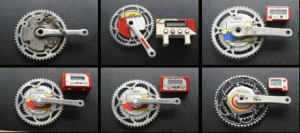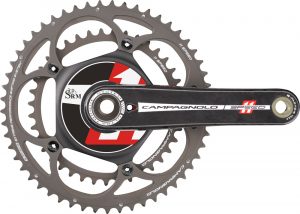
Power Meter Type: Strain gauge. Crank mounted.Point of Origin: Germany
Years in Business: Since 1986
U.S. Service Center: Yes. Colorado.
Web Site: www.srm.de
Overview: There is something great about a well executed original product that has kept up with the times. SRM is the original power meter and they have been developing power meters for significantly longer than any other company. In the 1980’s, a medical engineer named Ulrich Schoberer wanted to allow riders to gain power information like they could in a lab setting while riding outdoors. In 1986 he made this a reality with the advent of the first SRM. Ulrich’s original idea was to put the power meter in the pedals, but the technology proved too bulky and complicated to be ridden outside at the time and he went with a crank based design instead. Ulrich chose the crank as it is a bigger and more universal component than the pedals and is also very close to the point of origin for power production (the bike’s contact point with the feet).

Since 1986, Ulrich’s design idea has progressed markedly as athletes from Greg LeMond to Lance Armstrong and Normann Stadler all started training with power and using SRM to do so. SRM was also smart enough to recognize that power meter users like to use the very best shifting and lightest cranks and they have integrated SRM systems into modern cranks made by top drivetrain companies like Shimano, SRAM, Campagnolo, FSA and others.
Today, SRM is still considered one of the most reliable and accurate power meter options available. The level of accuracy, refinement of design, low incidence of failure and strong support structure (SRM offers a U.S. service center that handles distribution as well as all repairs and modifications) combined with few compromises in regards to component and frame compatibility continues to keep SRM in the power meter game decades later. SRM units are available for road or MTB applications.
SRM Power Meter Pros:
- The original. The most refined and proven power meter design on the market.
- Can be used with any wheelset without having to buy another power meter.
- Available in a wide range of high quality crank options.
- The most proven design currently available.
- U.S. Service Center that is 100% dedicated to SRM distribution and service.
- Usually realistic to switch between bikes.
- ANT+ Sport compatibility means you can use a SRM PowerControl or any ANT+ Sport head from Garmin, PowerTap and others.
- Lab/Science version offers accuracy to 0.5%.
- The primary power meter that our resident multiple record holding TT ace Dean Phillips uses for aerodynamic field testing.
SRM Power Meter Considerations:
- Not as easy to change between bikes as a pedal based system. With a SRM, like Quarq, you need to be able to change a crankset.
- Priced higher than most other options.
- Crankset needs to go back to SRM when power meter battery needs recharging/servicing. This is a 1-2 year interval for most riders.
Accuracy: The vast majority of SRM units today are sold in the +/-2% version. However, SRM also offers a lab unit that tests to +/- 0.5% for those looking for the tightest accuracy currently available.
Reliability/Maintenance: SRM has a strong reliability record. Maintenance is minimal, but having to send the unit back for service to recharge the power source every couple years is inconvenient when most systems allow for an easy user-serviced battery change.
Compatibility/Limitations: SRM has relatively few compatibility issues and most of their units will work on the vast majority of frames available today. On their web site, SRM offers charts that show compatibility for some of the more popular frame options. Links are as follows:
Road Bike/Frame Compatibility
Time Trial Bike/Frame SRM Compatibility
Mountain Bike/Frame SRM Compatibility
Track Bike/Frame SRM Compatibility
Display Quality/Features: While most any ANT+ Sport cycling computer head may be used, the SRM PowerControl is an impressively thought out and refined head. You can choose how often the unit records data between 0.5 and 2 seconds and, with the setting at 1 second, it will store an impressive 130 hours of data. Battery life is also very good with up to 30 hours between charges and you can adjust most of the display options to suit your individual needs.
Weight: The SRM Power Meter crankset varies greatly in weight, depending on the crank it is built into. SRM usually adds 180-210 grams of weight to the crankset (if a stock Dura Ace 7900 crankset weighs 640 grams, a SRM unit will weigh about 830).
L/R Power Balance: Current generation SRM units offer L/R power balance.
Ease of Installation and Transfer between Bikes: Wired SRM units used to be quite challenging to install on some frames, but that feels like the ancient past now; ANT and ANT+ Sport have changed this for the better. With accelerometer based cadence and wireless transmission, mounting a SRM can be as simple as sliding the new crankset into your bottom bracket (assuming you get a SRM that is compatible with your current bottom bracket) and mounting the computer to your handlebar. Of course, you need to setup the data fields in the computer of your choice, enter your personal information, activate power meter functions and pair the units (true with all power meters). Transferring a SRM power meter between bikes is as easy or as difficult as any crank transfer between bikes. In other words, “It all depends on the bikes and the bottom brackets.”
Software/Hardware: While many riders choose to use aftermarket software, like TrainingPeaks, with their power meter, the software that comes with an SRM is solid and powerful. Like SRM’s hardware, SRM’s software has been developed over decades and it is a pretty polished, if not slightly over engineered, package. SRM software allows you to break down many variables of your ride data and offers powerful graphing, sorting and comparative functions. While few of us will have the need for it, the telemetric options that you may have seen displaye d next to the rider on TV during Pro Tour races is impressive and being able to stream data from multiple riders into real time video is pretty cool no matter how you look at it.
d next to the rider on TV during Pro Tour races is impressive and being able to stream data from multiple riders into real time video is pretty cool no matter how you look at it.
Conclusions: We have a hard time not liking how refined and versatile the SRM design is and we also like the engineering and details that are evident in SRM’s execution. The integrated Campagnolo unit that still preserves much of the Campagnolo aesthetic is a good example. SRM’s are some of the priciest power meters on the market and there are other units that have proven their accuracy and competitiveness in this very competitive category.
Call or email for more information on SRM power meters or to order!
